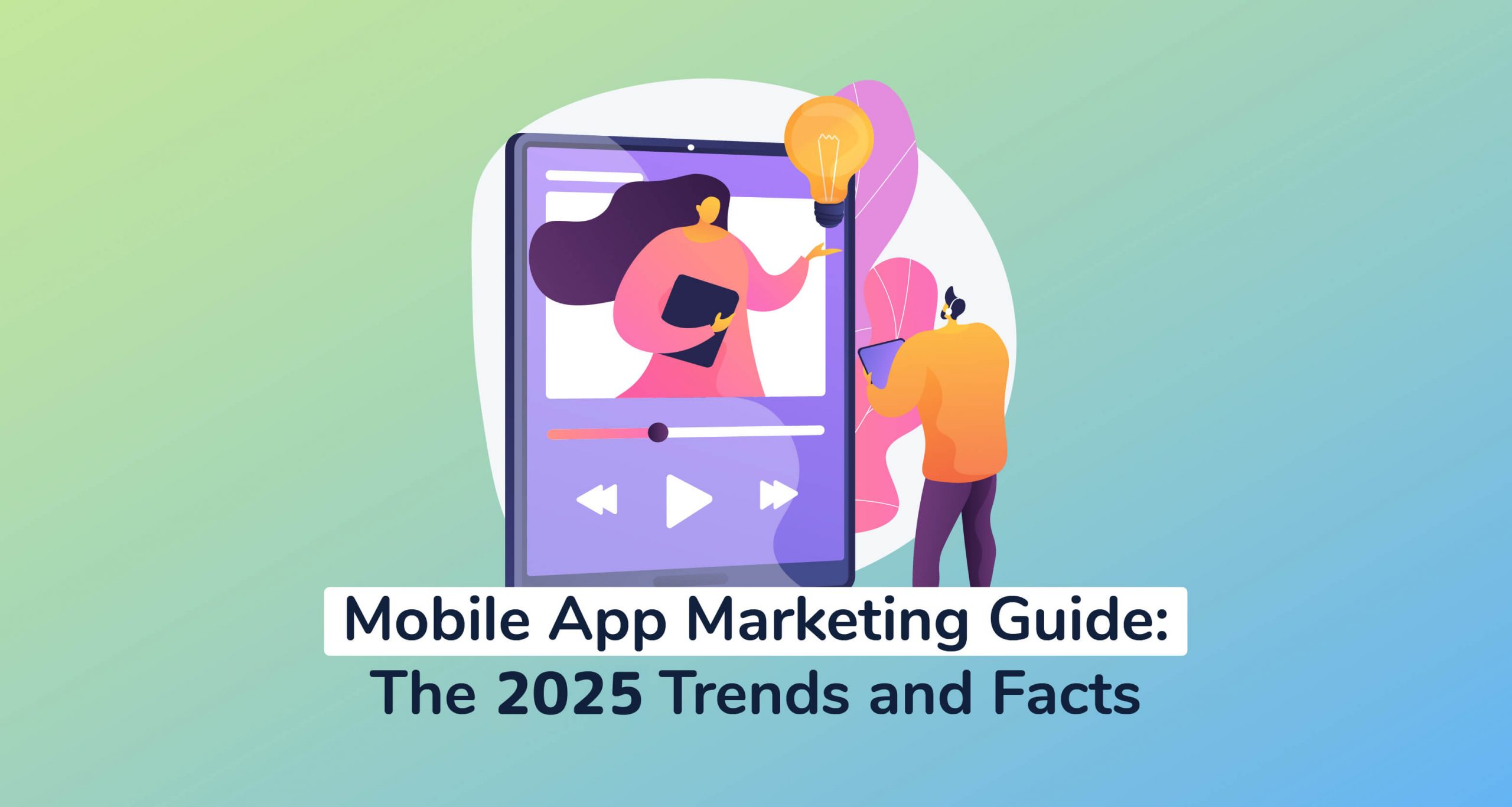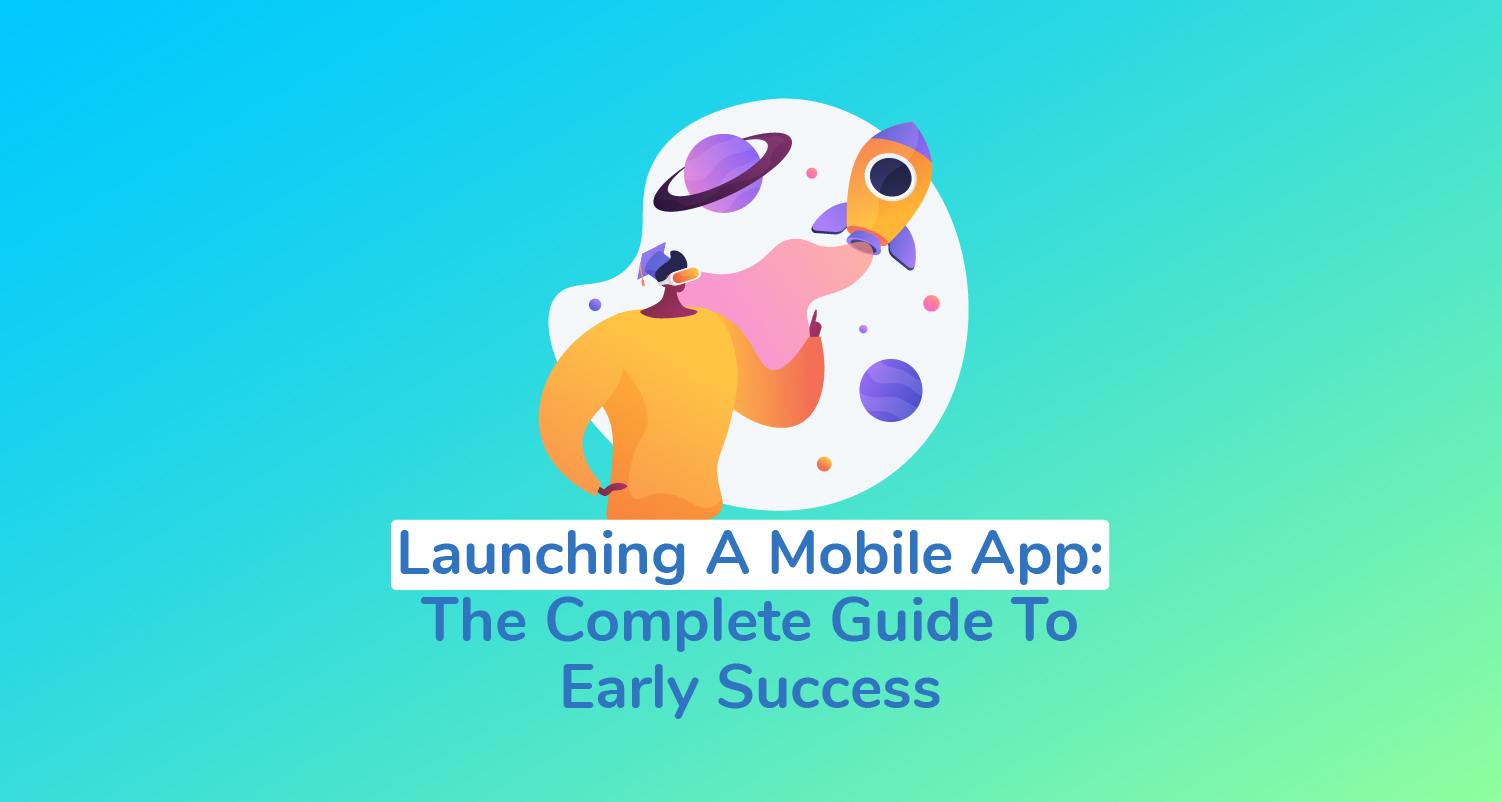
Push Notification Tips For Mobile App Marketing
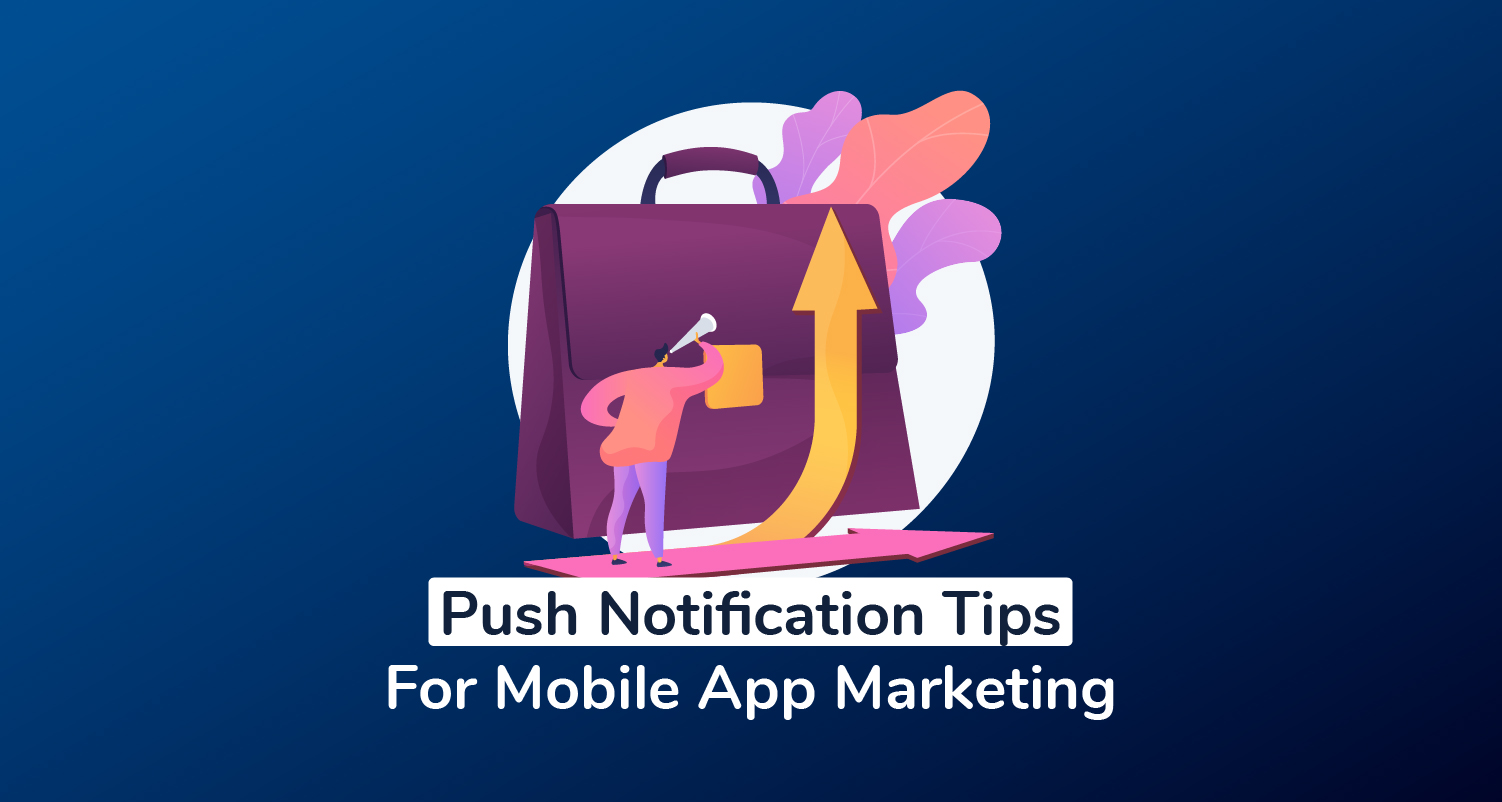
At a time when both iOS and Android mobile app users are increasingly silencing their push notifications, it’s understandable why controversy is now brewing over the efficacy of push alerts in mobile app marketing.
Yes, let’s face it. The truth is, the once resoundingly popular push notifications have been losing their luster among app developers, app owners, and app marketers. Quite a number of them believe that this mobile marketing strategy is not as impactful anymore.
Table of Contents
-
-
- What Is A Push Notification?
- The Role Of Push Notifications In Mobile App Marketing
- Why Use Push Notification Messaging For Mobile App User Retention Campaigns?
- Types Of Push Notifications In Mobile App Marketing
- #1: Standard Push Notification
- #2: Rich Push Notification
- #3: Location-Based Messaging
- Push Notification Vs. In-App Messaging
- Benefits of Push Notifications In Mobile App Marketing
- 4 Expert Tips That’ll Transform Your Push Notification Mobile App Marketing
- #1. Get Creative With Your Opt-Ins
- #2. Avoid Mixing Up iOS And Android Push Notification Strategies
- #3. Personalize Your Push Notifications
- #4. Adopt Geo-fencing
- Key Takeaways
-
Interestingly, these sentiments are even echoed by a couple of notable market research reports. One of the most recent ones, for instance, was published by Kahuna, a mobile marketing automation software provider. The company’s survey on consumer engagement established that 60% of mobile app users are now opting out of push notifications.
Shocking?
Ok, while this revelation is not very encouraging, things are really not as bad as they might seem. While some might argue that such reports spell doom for push notifications, the fact is, the market findings have essentially exposed this type of mobile app marketing strategy as a half-full, half-empty situation.
That means that while leveraging push notifications has its challenges, it can still be an incredibly effective mobile app marketing strategy. You just need to learn how to take advantage of the half-full side.
Now, that’s precisely what this mobile app marketing guide seeks to help you with. It explains the basics of push notification engagements and then walks you through a couple of proven mobile app marketing tactics that PreApps has developed over the years.
Hence, you can think of this as the formula that’ll boost your push notification engagement with the target audience.
What Is A Push Notification?
As far as smartphones are concerned, a push notification is basically a one-way automated app message that occasionally appears on your home screen or notification bar when its host app is inactive.
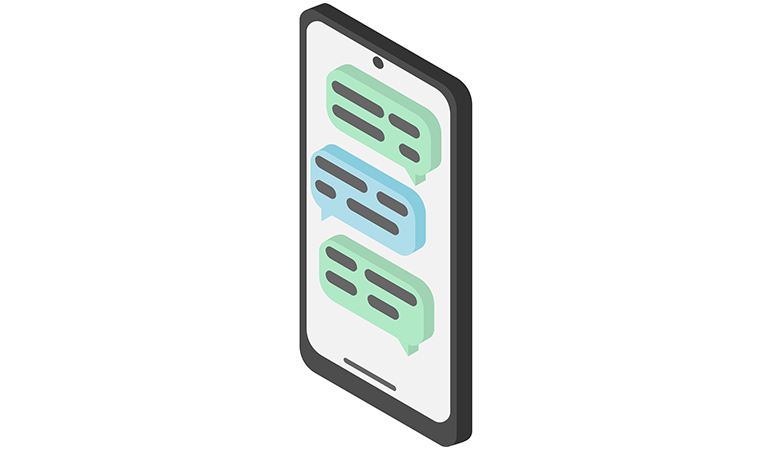
Mobile app developers typically use it to engage mobile app users and perhaps advise them on upcoming updates, new app features, recent news, plus any other relevant app information.
Now, make no mistake about it. While the push notification feature is normally built right into the mobile app, the subsequent push messages are displayed even when the underlying mobile app is dormant.
They just pop up on the screen at any time of the day or night to connect with mobile app users, regardless of whether they are logged into the host app or not.
The Role Of Push Notifications In Mobile App Marketing
If you ever intend to use push notifications in mobile app marketing, you ought to keep in mind that this type of messaging doesn’t operate like other regular app promotion strategies.
While content marketing, social media marketing, App Store Optimization, and other popular app marketing campaigns fundamentally seek to drive app install numbers from potential users, push notifications are built to engage their target audience after the app downloads.
You can blame that on the interdependence between push notifications and mobile apps. While social media marketing (eg Twitter and Facebook ads), content marketing (eg landing pages) can run independently from the mobile apps and the app market, push notifications run entirely within their host mobile apps’ ecosystem.
That, in essence, disqualifies push notification as a mobile marketing strategy for app user acquisition. It’s only the likes of content marketing combined with App Store Optimization, landing pages, and social media that are capable of engaging potential users to drive conversions.
Push notifications, on the other hand, are exclusively reserved for app user retention campaigns. Once App Store Optimization, landing pages, and social media app promotions convert potential users into actual mobile app users, push notifications to take over from thereby encouraging the users to keep interacting with the mobile app.
And why is this important?
Well, the thing is, mobile app users tend to lose interest pretty fast. Unless you find a way to keep them engaged, chances are that most of them will uninstall your mobile app just days after downloading it from the App Store.
Food and drink apps, for instance, retain only 16.5% of their users on day one. The high churn rate doesn’t stop there, though – the numbers typically drop to 7.2% by day seven, followed by 3.9% by day 30.
Mobile game apps, on the other hand, perform remarkably well on day one – with hypercasual gaming retaining as much as 32.3%. The good tidings don’t last that long, however, as the app user retention rate drops quite drastically to 8.3% by day seven, followed by 2.3% by day 30.
This problem is universal, affecting mobile apps across both the Apple App Store and Google Play Store. As such, you can’t afford to leave out push notifications from your app retention marketing strategy.
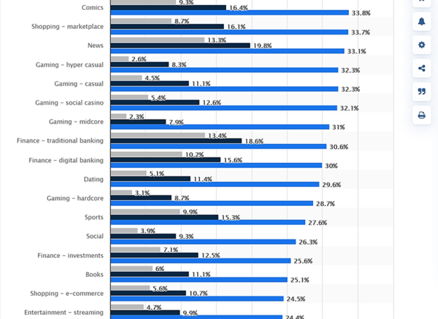
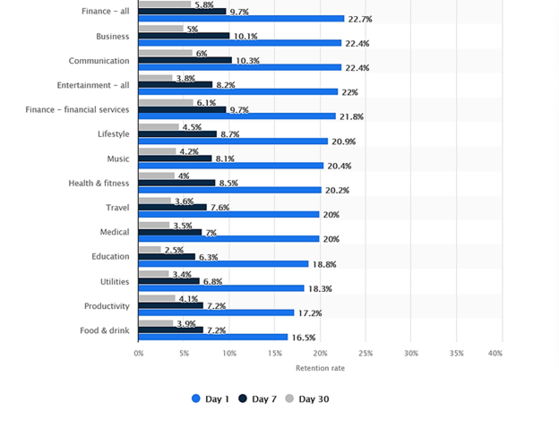
Ok, fair enough. But then again, how effective is push notification messaging in keeping mobile app users engaged? How does it perform compared to other app user retention strategies?
Why Use Push Notification Messaging For Mobile App User Retention Campaigns?
While engaging your mobile users might seem like a simple task at first, you’ll soon notice just how difficult it is to keep them engaged over the long haul.
Now, speaking of which, it turns out that push notification messaging is not the only engagement channel for app user retention campaigns. You could also connect with your target audience through social media, email marketing, or maybe Google UAC.
Facebook, for instance, offers a range of powerful campaign tools that are optimized for app user retention. The only problem is, you won’t be able to run the app promotions organically. Instead, you’ll be forced to run paid ads on this social media platform if you intend to take advantage of its automated app user retargeting.
The same applies even to less popular social media sites like Twitter. You can only granularly reach out to your mobile app users through the paid Twitter App Cards.
Then to make matters worse, the cost itself could easily run into thousands of dollars after a short period of time – as Twitter for Business charges between $1.50 and $2.50 for every single engagement from your target audience.
Email marketing is another channel you could use to connect with your mobile app users. This is a nice touch, I admit, but then again – the average email open rate, even when it comes to mobile app marketing, is 18%. The accompanying click-to-open rate averages at 14.1%, while only 2.6% of the recipients ultimately manage to click through.
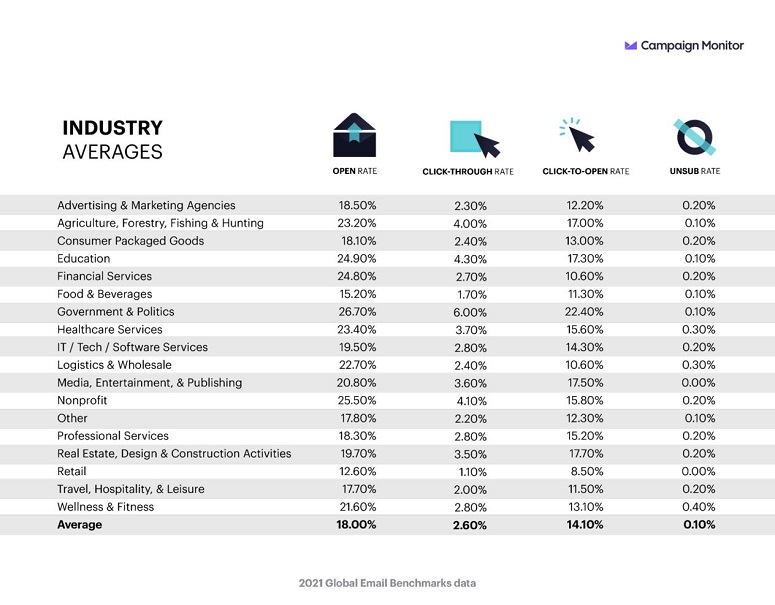
Push notification app marketing, on the other hand, dwarfs email marketing and the rest by a huge margin.
Going by the latest industry figures the open rate for push notifications is – get this – a remarkable 90%. That translates to a difference of more than 70% between push notification campaigns and email marketing.
But, that’s not all – it gets better. The subsequent click rate is even more impressive – as push notification campaigns outperform email marketing by about 7 times.
On the flip side, however, there’s also this disturbing fact that we’ve mentioned in the initial paragraphs of the article. Yes, I’m talking about that whole saga where 60% of mobile app users are reportedly opting out of push notifications.
Well, turns out it’s all true. But, don’t get it all wrong – if you closely scrutinize Kahuna’s survey report, you’ll notice where the confusion lies.
The thing is, the 60% figure shouldn’t be mistaken for the overall opt-out rate. Rather, it basically means that six out of ten mobile app users have, at one time or another, opted out of push notifications.
And why is that?
Well, it emerges that mobile app users are now more selective than ever about their push notification messages. It’s this intuitive bias that drives them to block push alerts from some of their mobile apps, and instead, opt into push notification campaigns that they consider to be the most valuable, time-sensitive, and relevant.
In terms of figures, 70% of mobile app users today have positive sentiments towards push notifications. They find them to be quite useful and relevant to their interests.
Then on the other end of the spectrum, it turns out that only 8% admit to consistently ignoring their push notification messages.
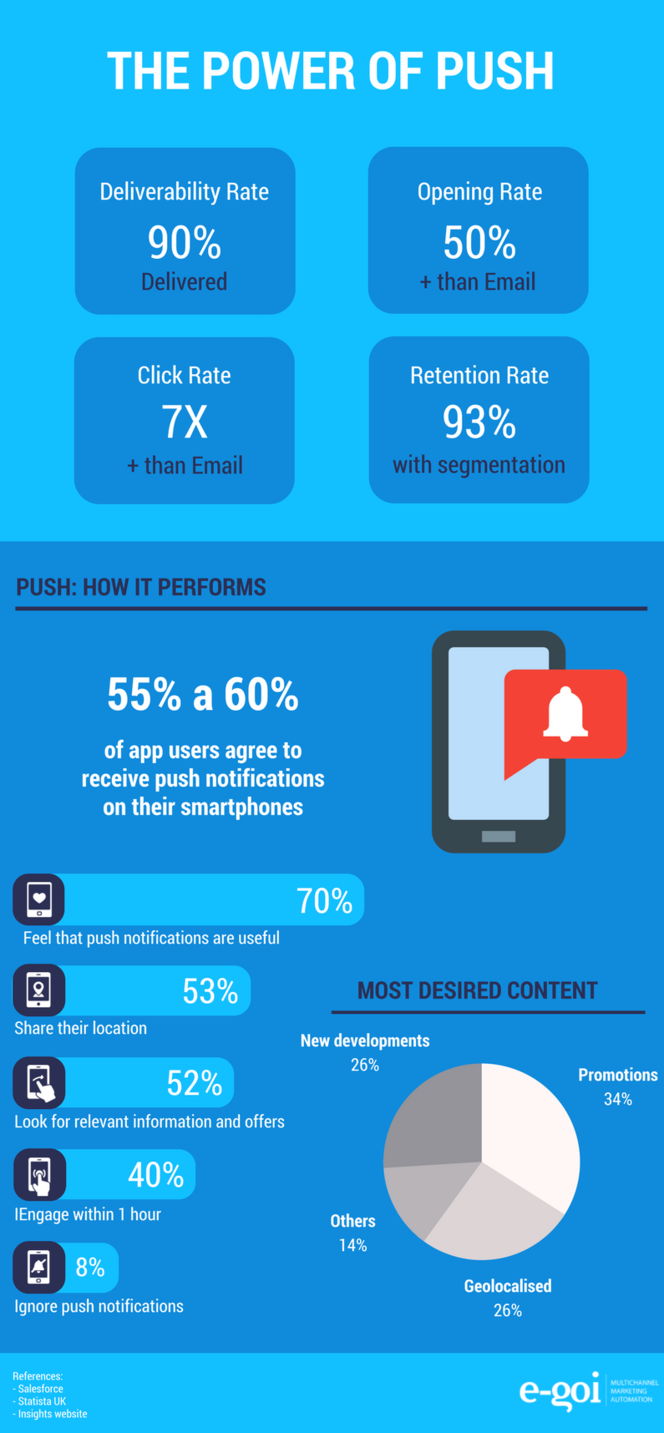
The corresponding opt-in rates are quite reassuring too. While the trends vary from one industry to another, the combined average opt-in rate of push notifications is about 63%. Travel and transportation apps lead the pack with 78%, while medical, health, and fitness apps manage only 35%.
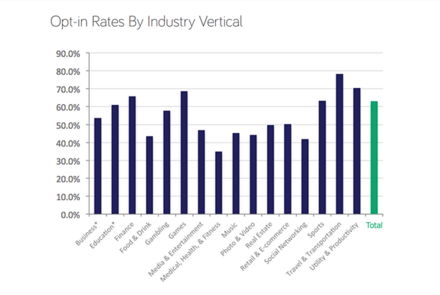
In particular, this mobile app marketing strategy should be less challenging on the Android platform, as Google Play Store apps boast an average opt-in rate of 78%. iOS App Store apps, on the other hand, are lagging far behind with an average opt-in rate of 45%.
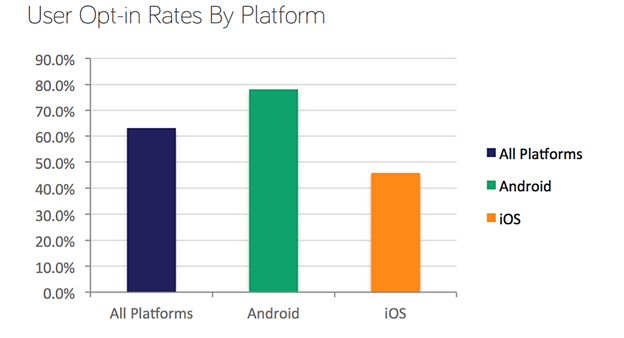
Types of Push Notifications In Mobile App Marketing
There are three primary types of push notifications used in mobile app marketing:
- Standard Push Notifications
- Rich Push Notifications
- Location-Based Messaging.
#1: Standard Push Notification
This is a push notification that only communicates in text.
Because of its simplicity, a standard push notification is inarguably the most commonly used type in mobile app promotions.
#2: Rich Push Notification
While the standard one only comes with text, a rich push notification is a multimedia message that includes different types of media – text along with GIFs, videos, or images.
This dynamic combination makes it more engaging and impactful.
That said, it’s worth noting that rich push notifications have not been around for as long as their standard counterparts. Android mobile apps only started displaying them in 2015, while iOS users had to wait till the fall of 2016.
#3: Location-Based Messaging
This is a standard or rich push notification that targets mobile app users based on their specific location. It capitalizes on geofencing approaches to personalize information in a way that corresponds to a mobile app user’s precise geographical position in real-time.
Push Notification Vs. In-App Messaging
As you can tell, a push notification almost sounds like an in-app mobile marketing strategy. However, there are distinct differences between the two that you ought to keep in mind.
For starters, it’s worth noting that push notification messaging is not an in-app marketing tactic. The two happen to operate very differently.
So, how do you figure out which is which?
A push notification, in essence, is built to simply pop up on your home screen without necessarily launching its host mobile app. It seemingly just appears from nowhere even when you’re not actively using its mobile app.
This alone makes it exceptionally appropriate for engaging dormant mobile app users. It effectively grabs the attention of your target audience without warning.
Sadly, that could also be a major disadvantage when you come to think of it. You see, a randomly displayed app marketing message might turn out to be intrusive and irritating to some app users, especially if it repeatedly shows non-contextual content.
This is how some mobile app marketers find themselves on the wrong side of their target audience – which, more often than not, leads to dismissals and opt-outs.
Such predicaments are actually more common than you think. Maintaining a weekly messaging frequency of just 6 to 10 push notifications, for instance, could lose you up to 31% of your mobile app users.
So, in a sense, every single message is like a gamble. One wrong move during the week is enough to trigger opt-outs from 10% of your mobile app users.
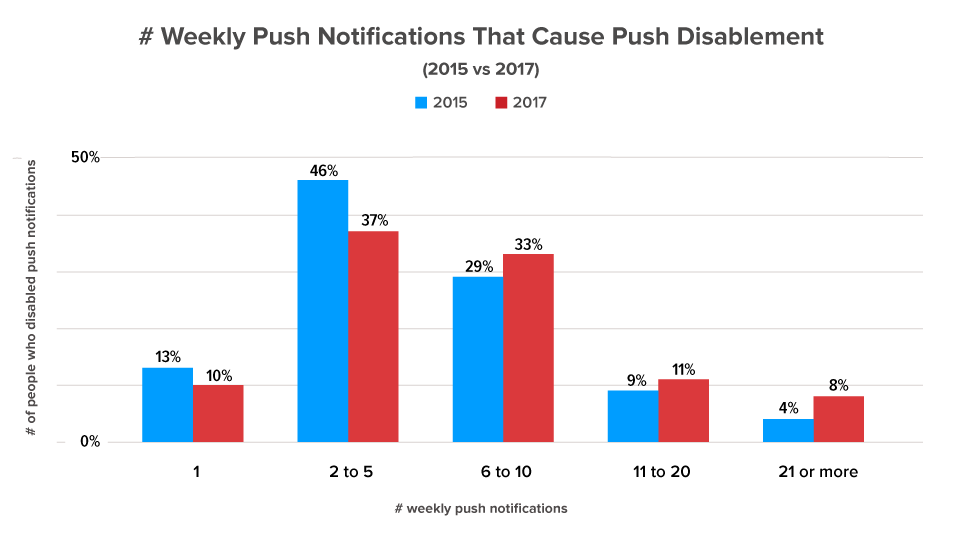
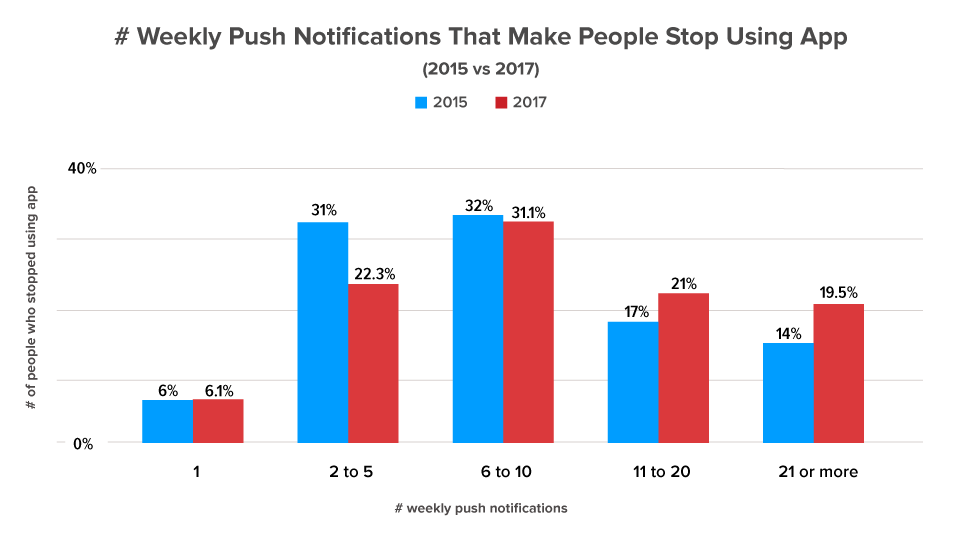
Now, in-app messaging, on the other hand, is the direct opposite of a push notification. Instead of randomly appearing on the home screen, the information is restricted within the mobile app itself. Hence, a mobile user has to launch the app and actively interact with it to view the message.
The good thing about in-app mobile marketing is this – you can use it to target your mobile app users based on their specific app activities. And if the message itself is contextually personalized, you’ll have an easy time maintaining a favorable app user retention rate.
On the flip side, however, it’s worth noting that while it’s exceedingly impactful, in-app mobile marketing cannot match up to the potential reach of push notifications. The number of people who get to see your message is substantially lower.
Benefits of Push Notifications In Mobile App Marketing
It goes without saying – push notifications are incredibly effective when it comes to mobile app marketing.
The potential reach itself, for instance, is tremendously high because people are always on their smartphones.
According to a report from Fluent Inc, engagement is highest when you reach out to your target audience via their cell phones. People are nearly three times as likely to open an email on their mobile phone than on their computer, and they typically spend more time staring at their phone screens than on TVs.
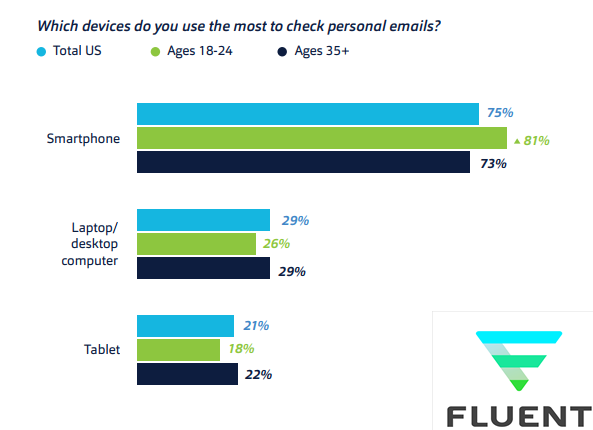
Furthermore, the average American checks their phone over ninety times a day – which translates to about once every ten minutes.
As a result, it shouldn’t take long for your push notification message to get noticed. And in terms of numbers, it has been established that about 40% of smartphone users engage with push messages within 60 minutes of receiving them. That’s almost as instantaneous as SMS messaging.
All in all, there are numerous mobile apps that have successfully hacked the use of push notifications as an app marketing strategy
The New York Times, for example, is one particular brand that has managed to capitalize on push messages to substantially boost its app subscriptions. This is what ultimately pushed its revenue growth beyond $1 billion by 2017.
Interestingly, the success was so outstanding that the company even hired a dedicated team of push notification marketers on a full-time basis. They now handle the scheduling and development of push messages in a bit to keep the mobile app users engaged.
Now, in case you’re wondering, the answer is yes – it’s indeed possible to replicate such success on your mobile app. You just need to approach your app user engagements with some level of finesse.
Here are some critical actionable tips that’ll help you achieve that in your push notification mobile app marketing campaigns
4 Expert Tips That’ll Transform Your Push Notification Mobile App Marketing
#1. Get Creative With Your Opt-Ins
Fact is, it’s impossible to randomly send out push notifications to just any mobile app user. Recipients have to fundamentally opt-in to the campaigns, before you can proceed to add them to your target audience.
It’s pretty easy to build and customize digital opt-in forms and requests. But, don’t rush it.
By now, I bet you’ve seen quite a number of poorly designed forms and opt-in requests. I’m talking about the ones that reach out to their mobile app users with bland and uninspiring requests.
Well, of course, that might win you a couple of user subscriptions. But, let’s be honest – you’ll ultimately end up with only a handful.
So, to avoid such a disappointing outcome, consider designing a special attention-grabbing opt-in box. It should elegantly blend in with your mobile app, and creatively outline all the opt-in options.
Most importantly, though, ensure that all the options are clear and easy to understand. Your mobile app users should be able to figure out everything right from the bat.
Consider these opt-in messages, for instance. Which of them would you say is more interesting and appealing?
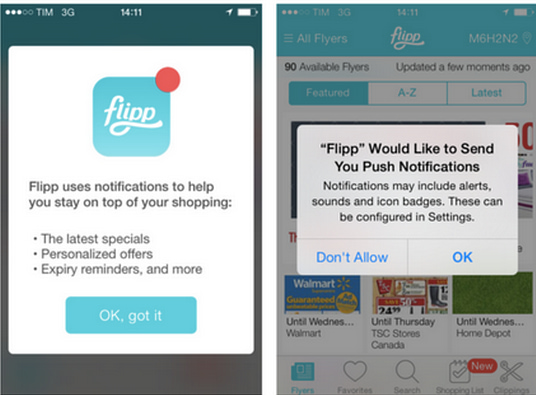
The one on the left explains all of the benefits you will receive from opting in – it highlights the accompanying deals, sales, and personalized offers.
In contrast, the push notification on the right makes it seem like you’ll be receiving lots of potentially annoying alerts.
Do you get the idea?
Here is another example of a brief but thoughtful way of structuring your opt-in request.
- Text: “We use push notifications to provide updates about exclusive deals for our users”
- Choices: “Keep me informed”; “Not Required”
Simply put, you might want to highlight the benefits that consumers will receive after opting in. Market research, in fact, suggests that mobile app users popularly prefer opt-in benefits like promotions, new developments, and localized offers.
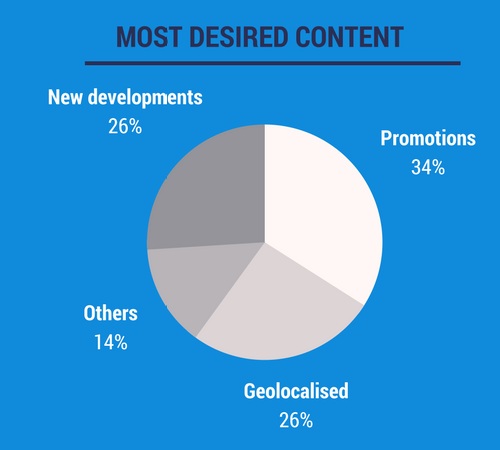
#2. Avoid Mixing Up iOS And Android Push Notification Strategies
Just like we’ve seen with App Store Optimization, the push notification systems across iOS and Android platforms have been set up differently. They vary in not only build and structure, but also the mode of operation.
So, if you happen to have published your mobile app on both the Google Play Store and the Apple App Store, don’t make the mistake of running similar push notification strategies.
To understand why consider the average push notification click-through rate for iOS App Store apps as well as Android mobile apps. Right off the bat, you’ll notice that iOS app users seemingly open way fewer messages than their Android counterparts.
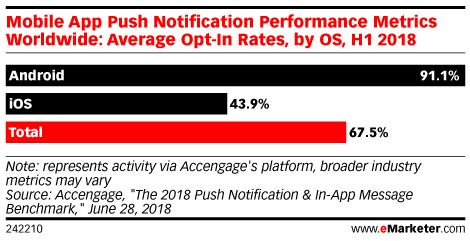
The reason behind this is actually quite simple.
Android push notifications typically remain visible throughout, and only clear you delete them manually. In contrast, Apple devices are designed to automatically get rid of iOS push notifications as soon as you unlock the home screen – after which you’ll find them within the pulldown menu.
Going by this and many other observable differences between the two platforms, it would not be a good idea to apply identical push notification parameters.
You might want to exclusively plan and execute your iOS push notification mobile app marketing – according to the functionalities and operability of the Apple iOS platform.
#3. Personalize Your Push Notifications
If you’re planning to randomly remind your users about the mobile app features, your push notifications may prove to be counterproductive.
All things considered, the principal difference between an annoying spam message and an engaging one is personalization. Personalized notifications have a 9% higher open rate than generic messages.
Now, to personalize your push notification marketing accordingly, you need to collect data about your mobile app users, analyze it, and then use the findings to segment your target audiences. Each of the resultant groups should subsequently be targeted with its own uniquely personalized messages.
Some of the grouping parameters that you could use for segmentation include:
- Level of app interaction- active or inactive
- Type of device
- User behavior
- App interaction history
- Purchase history
- Time zone
#4. Adopt Geo-fencing
Just like the name suggests, geo-fencing entails capitalizing on specialized systems to segment your audience based on their specific geographical locations in real-time. The goal here is to fine-tune your notifications according to the app users’ movements.
Currently, 26% of app users desire geo-localized push messages. And considering 53% of mobile app users tend to keep their location tracking feature on, you should be able to proceed without any major issues.
One particularly prominent app that perfectly takes advantage of geofencing in its push notification marketing is Uber. Since its app launch, Uber has managed to win users and enhance app retention by simply offering personalized location-based offers.
You can use a similar approach and reach out to various user groups with relevant real-time offers.
Key Takeaways
All in all, you might want to keep in mind that:
- A survey on consumer engagement established that 60% of mobile app users are now opting out of push notifications.
- A push notification is basically a one-way automated app message that occasionally appears on your home screen or notification bar when its host app is inactive.
- Mobile app developers typically use push notifications to engage mobile app users and perhaps advise them on upcoming updates, new app features, recent news, plus any other relevant app information.
- While content marketing, social media marketing, App Store Optimization, and other popular app marketing campaigns fundamentally seek to drive app install numbers from potential users, push notifications are built to engage their target audience after the app downloads.
- While social media marketing (eg Twitter and Facebook ads), content marketing (eg landing pages) can run independently from the mobile apps and the app market, push notifications run entirely within their host mobile apps’ ecosystem.
- Push notifications are exclusively reserved for app user retention campaigns.
- Once App Store Optimization, landing pages, and social media app promotions convert potential users into actual mobile app users, push notifications to take over from there to encourage the users to keep interacting with the mobile app.
- Food and drink apps retain only 16.5% of their users on day one, 7.2% by day seven, followed by 3.9% by day 30.
- Mobile game apps for hypercasual gaming retain as much as 32.3% on day one, 8.3% by day seven, followed by 2.3% by day 30.
- Although Facebook offers a range of powerful campaign tools that are optimized for app user retention, you won’t be able to run the app promotions organically.
- Twitter for Business charges between $1.50 and $2.50 for every single engagement from your target audience.
- The average email open rate, even when it comes to mobile app marketing, is 18%. The accompanying click-to-open rate averages at 14.1%, while only 2.6% of the recipients ultimately manage to click through.
- The open rate for push notifications is a remarkable 90%.
- The subsequent click rate is even more impressive – as push notification campaigns outperform email marketing by about 7 times
- Mobile app users block push alerts from some of their mobile apps, and instead, opt into push notification campaigns that they consider to be the most valuable, time-sensitive, and relevant.
- 70% of mobile app users today have positive sentiments towards push notifications. They find them to be quite useful and relevant to their interests.
- Only 8% of mobile app users admit to consistently ignoring their push notification messages.
- While the trends vary from one industry to another, the combined average opt-in rate of push notifications is about 63%. Travel and transportation apps lead the pack with 78%, while medical, health, and fitness apps manage only 35%.
- Google Play Store apps boast an average opt-in rate of 78%. iOS App Store apps, on the other hand, are lagging far behind with an average opt-in rate of 45%.
- Standard Push Notifications communicate exclusively in text.
- A Rich Push Notification is a multimedia message that includes different types of media – text along with GIFs, videos, or images.
- Location-Based Messaging capitalizes on geofencing approaches to personalize information in a way that corresponds to a mobile app user’s precise geographical position in real-time.
- Maintaining a weekly messaging frequency of just 6 to 10 push notifications could lose you up to 31% of your mobile app users.
- One wrong message during the week is enough to trigger opt-outs from 10% of your mobile app users.
- Instead of randomly appearing on the home screen, in-app messaging is restricted within the mobile app itself. Hence, a mobile user has to launch the app and actively interact with it to view the message.
- People are nearly three times as likely to open an email on their mobile phone than on their computer, and they typically spend more time staring at their phone screens than on TVs.
- The average American checks their phone over ninety times a day – which translates to about once every ten minutes.
- 40% of smartphone users engage with push messages within 60 minutes of receiving them.
- Consider designing a special attention-grabbing opt-in box. It should elegantly blend in with your mobile app and creatively outline all the opt-in options.
- Market research, in fact, suggests that mobile app users popularly prefer opt-in benefits like promotions, new developments, and localized offers.
- iOS app users seemingly open way fewer messages than their Android counterparts.
- Personalized notifications have a 9% higher open rate than generic messages.
- Geo-fencing entails capitalizing on specialized systems to segment your audience based on their specific geographical locations in real-time. The goal is to fine-tune your notifications according to the app users’ movements.
- 26% of app users desire geo-localized push messages.
Conclusion
Over time, push notifications will keep your mobile app users engaged and, subsequently, increase the amount of time they spend in your app, plus the overall app user retention rate.
Don’t get carried away by the engagement levels, though. As mobile app users continue to respond positively to your mobile app marketing messages, resist the temptation of increasing your messaging frequency. You need to limit your push notifications in such a way that the high engagement levels are maintained without overwhelming the mobile app users.
Then if you’d like to take it up a notch, you can go ahead and schedule a call today. Our mobile app marketing experts will review your app growth needs, after which they’ll transform your efforts into a fully automated data-backed omnichannel app promotion system.
PreApps has, through the years, successfully promoted more than 3,300 mobile apps using tested and proven techniques. So, you can count on us to lead your mobile app to even greater heights.
Newsletter
Don’t miss a thing! Sign up to receive daily news
Subscribe Newsletter




